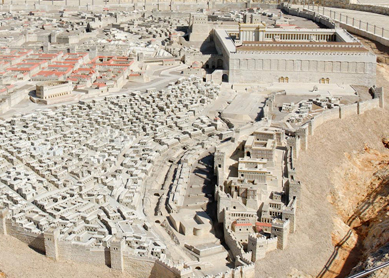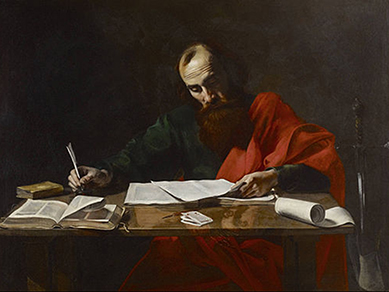First-century C.E. Jerusalem was impressive by anyone’s standards. With a population of tens of thousands—by some estimates, even 100,000 or more—it was the largest city in Palestine. The Roman naturalist Pliny the Elder (23–79 C.E.) described it as “the most famous city in the East, not just in Judea” (Natural History 5.70).
Its primary source of prestige was the Second Temple, the most sacred site in Judaism and the only place where biblical tradition allowed animal sacrifice. Originally built around 515 B.C.E. to replace the temple destroyed by the Babylonians, the temple and its support buildings were completely renovated by King Herod (reigned 37–4 B.C.E.), whose architects combined Jewish, Near Eastern, Greek, and Roman features. Herod also doubled the size of the Temple Mount, creating the largest temple complex in the Roman world, and reorganized its courts, devoting a sizable area for Gentile visitors and a particular court for Jewish women. The temple was a pilgrimage site for Jews throughout the Roman world, some of whom traveled there to celebrate the festivals of Passover (Pesach), Weeks (Shavuot), and Booths (Sukkot). An annual half-shekel tax helped support the temple. The city’s elites especially benefitted from the economic impact of pilgrimage, and archaeological excavations have uncovered lavish residences with frescoed walls, mosaic floors, imported pots and dishes, and other luxury goods.
The city was structured around two hills, the eastern one with the temple and a western one now called Mount Zion. Jerusalem stretched south to include territory beyond the Old City’s present walls, which date only to the 1500s C.E. The city expanded northward in the first century C.E., with Agrippa I, a member of the Herodian dynasty, constructing a wall that was perhaps as much as 450 meters north of the modern wall. Greek and Roman architectural influence was very visible. The Jewish historian Josephus reports that Herod the Great built a theater in the city and an amphitheater “on the plain” and that a hippodrome (a stadium for horse races) existed there by the 60s C.E. (Jewish War 2.44, Jewish Antiquities 15.268 and 17.254-55). In important respects, however, Jerusalem differed from other major Roman cities. Visitors would not have seen the statues of emperors or deities or the temples to various gods that were commonplace elsewhere.
Governmental administration of the city shifted over the decades. After the death of Herod (4 B.C.E.), his son Archelaus succeeded him. When the Roman emperor Augustus exiled Archelaus in 6 C.E., Roman governors—appointed officials holding the title of either “procurator” or “prefect”—assumed control of Jerusalem and the rest of Judea. Aside from a three-year period (41–44 C.E.) of rule by Agrippa I, the city remained under direct Roman administration until the Great Revolt (66–70 C.E.). That uprising led to the destruction of the temple and the rest of the city, and archaeological excavations have found ample evidence of its toll. The ruined city became home to a Roman legion, and c. 130 C.E. Emperor Hadrian refounded it as the Roman colony of Aelia Capitolina, a city in which Jews were forbidden to live.
Bibliography
- Meyers, Eric M., and Mark A. Chancey. Alexander to Constantine: Archaeology of the Land of the Bible. Anchor Bible Reference Library. New Haven: Yale University Press, 2012.
- Bahat, Dan. The Atlas of Biblical Jerusalem. Jerusalem: Carta, 1994.
- Levine, Lee I. Jerusalem: Portrait of the City in the Second Temple Period (538 BCE—70 CE). Philadelphia: Jewish Publication Society, 2002.




